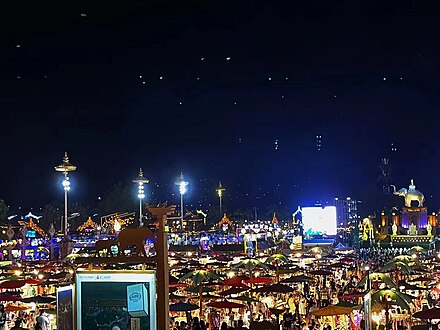Xishuangbanna - autonomous prefecture
Xishuangbanna (often just Banna is used; Chinese: 西双版纳; Lü: ᧑᧒ ᦗᧃ ᦓᦱ) is an autonomous prefecture in the south of Yunnan, near the Thai, Laotian, Vietnamese and Burmese borders. The ethnic groups and the local languages in this area are more Southeast Asian than Chinese.
 The region is a very popular destination for Chinese tourists. It offers most of the attractions of Thailand — warm climate, tropical fruits and flowers, elephants, jungle treks, cultural diversity, and a reasonably well-established tourist industry — without the complications of a border or different language and currency.
The region is a very popular destination for Chinese tourists. It offers most of the attractions of Thailand — warm climate, tropical fruits and flowers, elephants, jungle treks, cultural diversity, and a reasonably well-established tourist industry — without the complications of a border or different language and currency.
For other tourists, especially backpackers, the region serves as stop on the Banana Pancake Trail; it is on a major route between China and Southeast Asia. No matter who you are, the area is a major tourist destination.
Understand
"Xishuangbanna" is a name from the Dai language, "Xishuang" means twelve, "Banna" means an administrative unit that provides feudal taxes (literally translated as "twelve thousand rice fields"), and actually refers to twelve administrative regions.
The Xishuangbanna region has the best-preserved tropical ecosystem in China, with the only tropical rainforest in China. It is a nature reserve, a member of the United Nations Biodiversity Conservation Circle, and an observation point for sustainable tourism development of the United Nations World Tourism Organization. It has one-sixth of all plant species and one quarter of all animal species in China. Xishuangbanna is the second largest natural rubber production base in China, the origin of large-leaf tea, and the hometown of Pu-erh tea.
People
Xishuanbanna is a very ethnically diverse region, with the Dai people forming a plurality. The Dai people share close cultural ties with Thailand, speaking languages in the same family as Thai, and being Theravada Buddhists just like the Thais. Many Thai festivals such as Songkran and Loy Krathong are also celebrated by the Dai people. As in Thailand, Songkran is the most important festival in Xishuangbanna, when the streets erupt in a massive water fight.
Cities
- Jinghong, capital and main center of the region
- Mengla
- Menghai 📍
- Mohan, small town on the Laotian border
Talk
As anywhere in China, Mandarin is the lingua franca used for communication between speakers of different languages. However this area, like most of Yunnan, has several different ethnic groups and most of those have their own language. In Banna, the largest group are the Dai, ethnically and linguistically very similar to Thai people and language.
Get in
By plane
- Xishuangbanna Gasa International Airport (IATA: JHG), Gasa Town, Jinghong City, 21.970551°, 100.766455°, +63 691 215 9130. There are some flights from several Chinese cities, but much the most frequent are from Kunming. There are also a few flights from Bangkok; see Jinghong#Get_in. 2022-09-29
By highway
There is a highway south from Kunming into this region, via Pu'er.
By train
- Xishuangbanna Railway Station (西双版纳站). There are over 20 trains per day from Kunming. The journey time from Kunming to Jinghong is about 3 to 4 hours. 2022-10-07 The Yuxi-Mohan Railway runs through Xishuangbanna and connects the region to Kunming and the Laotian border. There are 5 passenger stations in Xishuangbanna. These include 3 stations in Jinghong as well as one station each in Mengla and Mohan. Xishuangbanna's main railway station is the Xishuangbanna Railway Station in Jinghong, which has much more frequent train services than the other stations. As of October 2022, there are not yet any direct train services from Laos, mainly due to Covid-related border restrictions.
Get around
By bus
The airport bus can easily reach the city from the airport, and the airport special line No. 1 also passes through the night market and temple attractions. The price is RMB 4. The tourist route can choose ordinary bus and tourist line. Among them, ordinary bus No. 1, No. 2, No. 3, and bus Z21 pass through many tourist attractions, and the price is RMB 3 yuan. Attractions will have corresponding tourist bus lines, most of which are 5 yuan for round trips. Payment methods can be credit card or coin.
By taxi
The starting price of taxis in Xishuangbanna is 7 yuan (3 kilometers), including 2 yuan fuel surcharge.
Rent battery cart
There are many places in Xishuangbanna where you can rent battery cars(Or a shared battery car parked on the side of the road). For many local residents, electric cars are one of the main ways to get around.
See

Streets and architecture
Religious sites
As most Dai people are Theravada Buddhists, the main attraction here is the Theravada Buddhist temples, which are very similar in architecture to those in Thailand and Laos.
- Xishuangbanna Zongfo Temple (西双版纳总佛寺), Jinghong, 21.98901°, 100.806054°. 2022-09-29
- Mange Temple (曼阁佛寺), Jinghong, 22.03082°, 100.804721°.
- Manjinlan Temple (西双版纳曼景兰大佛寺), Jinghong, 22.000803°, 100.803423°.
Parks and nature
- Xishuangbanna Tropical Botanical Garden (中国科学院西双版纳热带植物园), Mengla, 21.916943°, 101.270424°. 2022-09-29
- Manting Imperial Garden (曼听御花园), Jinghong, 21.99303°, 100.8072°. 2022-10-07
Museums
Border port
Other historical sites
Do
Stay in a Hani village homestay and visit tea plantations, do jungle hikes and try the local foods. 300 yuan per night with three meals included.
Eat
Local food
Restaurant
Night market
- Mekong Starlight Night Market (湄公河·星光夜市), Gaozhuang Xishuangshi Scenic Spot, Jinghong City, +63 691-2221171. open all day. 2022-09-29

Drink
Buy
Food
·Dried fruit(水果干) - Xishuangbanna is a tropical area, so there are plenty of fresh and dried tropical fruit.
Other
Stay safe
Go next
The prefecture borders Myanmar and Laos. Buses leave from Jinghong and Mengla to Luang Namtha. From Jinghong it costs RMB70 and takes 7 hours. Laos visas cost USD40 at the border; two extra passport photos are required.
Xishuangbanna Dai Autonomous Prefecture
xsbn.gov.cnYunnan
Primary administrative division